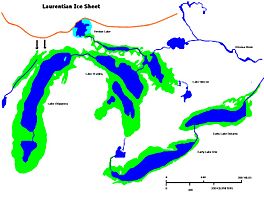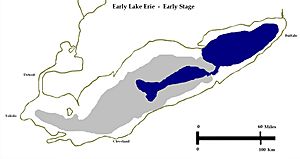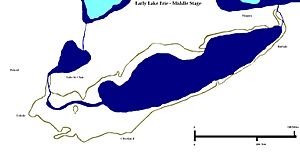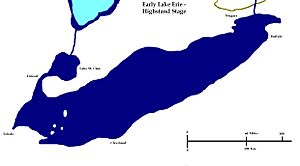Early Lake Erie facts for kids
Quick facts for kids Early Lake Erie |
|
|---|---|

Glacial Lakes Chippewa, Stanley, Early Erie and Early Ontario. Low-level lake stages during the end of the Wisconsin Glacial era in North America. Based on Larsen map, 1987.
|
|
| Location | North America |
| Group | Great Lakes |
| Coordinates | 42°36′N 79°42′W / 42.6°N 79.7°W |
| Lake type | former lake |
| Etymology | Lake Erie from the Erie Indians |
| Primary inflows | Detroit River |
| Primary outflows | Niagara River Welland Canal |
| Basin countries | Canada United States |
| First flooded | 13,000 years before present |
| Max. length | 241 mi (388 km) |
| Max. width | 57 mi (92 km) |
| Residence time | 300 years in existence |
| Surface elevation | 476 ft (145 m) |
Early Lake Erie was a huge ancient lake. It formed about 13,000 years ago, right after the last big ice age. This type of lake is called a proglacial lake, meaning it was created by melting glaciers. Early Lake Erie sent its water into another ancient lake called Glacial Lake Iroquois.
This old lake was similar in size to today's Lake Erie. However, for a while, a large part of its eastern side was still covered by ice. Early Lake Erie was actually made up of several smaller, shallower lakes. These included Lakes Warren, Wayne, Maumee, and Lundy. Today, much of the area that was once the ancient lake bed is now northern Ohio.
Contents
Early Low Water Stage
About 12,000 years ago, the huge Laurentian ice sheet (a massive glacier) melted away from the eastern side of the Lake Erie area. This melting created a new path for water to flow out of the lake basin. This path was at the Niagara Escarpment, which is a long, steep cliff.
At the same time, the ice sheet also opened a drainage route between Lake Algonquin and Lake Ontario. This meant that Lake Algonquin no longer sent its water into the Lake Erie basin.
The Holocene period (our current geological time) for Lake Erie began with a rush of water over the Niagara Escarpment. This powerful flow carved out a channel in the land, lowering the water level in the Erie basin. The Niagara River outlet, which is where the water flowed out, was more than 50 meters (164 feet) lower than today's Lake Erie. This created what we call Early Lake Erie, a non-glacial lake. At this stage, the water level was about 120 meters (394 feet) above sea level. The lake had two main parts: a larger one in the eastern basin and a smaller one in the central basin.
Water from Lake Algonquin Returns
Around 10,400 years ago, the ice sheet moved south again. This blocked the previous outlet for Lake Algonquin. Because of this, the Lake Erie basin once again started receiving water from Lake Algonquin. This water came through the Port Huron Outlet and a new river system that included the St. Clair River, Lake St. Clair, and the Detroit River.
All this extra water first created a marshy, wet area in the western part of the basin. Then, it formed a river system that flowed through the Pelee Passage. The shallow central part of the lake overflowed the Norfolk Moraine (a ridge of glacial debris). This created the Pennsylvania Channel, which flowed into the deeper eastern basin. For a short time, the eastern basin's water flowed over the Niagara Escarpment through the Niagara River. Scientists still discuss whether Early Lake Erie always had an overflow at this time or if it sometimes had no outlet.
Second Low Water Stage
By 10,300 years ago, a new outlet called the North Bay Outlet opened between Lake Algonquin and the St. Lawrence River. This caused the water level of Lake Algonquin to drop significantly. As a result, Early Lake Erie stopped receiving water from the upper lakes through the Port Huron outlet.
For several thousand years, Early Lake Erie did not get water from the lakes upstream. This period of low water lasted for about 5,000 years. The lake lost over 90 percent of its incoming water, becoming very still and stagnant. It also became "eutrophic," meaning it had too many nutrients, which can lead to algae blooms and less oxygen. This was made worse by less rain and more evaporation.
The lake became a "closed basin," meaning water flowed in but not out. Scientists found an old shoreline submerged below Lake Erie today. This Buffalo Ridge shoreline in the eastern basin is about 10 to 12 meters (33 to 39 feet) below the current river outlet.
During this time, the central basin was separate from the eastern basin. However, as the land in the eastern end slowly rose (a process called isostatic rebound where land bounces back after heavy glaciers melt), the water eventually topped the Norfolk Moraine. This created one larger lake with a deep channel called the Pennsylvania Channel. Another idea is that a lot of water from southern rivers flowed in, raising the water level and deepening the Pennsylvania Channel until the two basins joined into one lake.
Middle Water Stage
Around 10,000 years ago, the water levels in Early Lake Erie began to stabilize. By 7,500 years ago, the lake's elevation was about 145 meters (476 feet) above sea level. It continued to rise slowly for the next 2,000 years. This period is known as the "Middle Lake Erie" stage. At this point, the lake was about 25 meters (82 feet) below its current level. Some studies suggest it might have been 30 meters (98 feet) lower.
Scientists believe that less rainfall and more evaporation balanced out the changes caused by the land rising. This dry period, called the Xerothermic or Hypsithermal Interval, lasted for about 5,000 years (from 10,300 to 5,300 years ago). As the land continued to rise, the North Bay Outlet also rose. This led to the formation of the Nipissing Great Lakes, a larger version of today's upper Great Lakes. This happened around 5,400 years ago. Lake Erie remained somewhat isolated but continued to rise.
The Middle Stage ended around 5,300 years ago. At this time, water from Lake Nipissing was again diverted through the Port Huron outlet, flowing into Lake Erie. This increase in water, along with a more humid climate and rising water levels, created a large delta (a fan-shaped landform at a river's mouth) in the western basin, where the ancient Detroit River entered.
The remaining underwater features in Lake Erie, like the Buffalo Ridge and Norfolk Moraine, were flooded. These underwater obstacles changed how water circulated in the lake. This led to the formation of new land features above water, such as Long Point in Ontario and Presque Isle in Pennsylvania. The Lake St. Clair delta also formed during this time, between 5,000 and 3,600 years ago.
High Water Stage
Evidence from the shoreline shows that Lake Erie reached a "highstand" about 4,700 years ago. This means its water level was 3 to 4 meters (10 to 13 feet) higher than its current level. The Niagara River Outlet then eroded down to its present level about 3,500 years ago.
Becoming Modern Lake Erie
When Lake Erie reached its current level about 3,500 years ago, the southern rivers that had carved channels during the low-water stages became flooded. This created the "drowned" river mouths that are common along the western shore today. These flooded shores became the source of sand for beaches. This sand formed the massive sand spits we see at Long Point and Presque Isle. New spits also formed at Point Pelee, Ontario, and Cedar Point, Ohio. At the same time, barrier beaches formed across the mouths of most of these flooded rivers.





